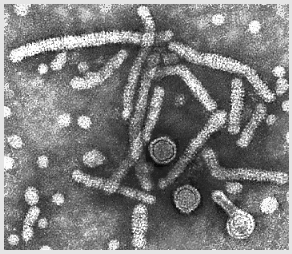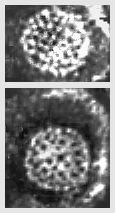Hepatitis B virus causes both acute and chronic liver infections in man. An unusual feature is the prolonged viraemia, lasting for up to several months in acute infections and for many years (even for life) in chronic infections.
A diagrammatic representation of the hepatitis B virion and the surface antigen components
Virions are 42nm in diameter and possess an isometric nucleocapsid or "
core" of 27nm in diameter, surrounded by an outer coat approximately 4nm thick. The protein of the virion coat is termed "
surface antigen" or HBsAg. It is sometimes extended as a tubular tail on one side of the virus particle. The surface antigen is generally produced in vast excess, and is found in the blood of infected individuals in the form of filamentous and spherical particles. Filamentous particles are identical to the virion "tails" - they vary in length and have a mean diameter of about 22nm. They sometimes display regular, non-helical transverse striations.
Core particles: The actual number and arrangement of the capsomers has not been established with certainty, but certain images suggest a lattice formation, as shown below.
A group of hepatitis B virions (right) and enlargements of the two exposed cores (indicated by arrows):
© Copyright Dr Linda M Stannard, 1995
This page was written by Dr Linda Stannard, on behalf of the Division of Medical Virology, UCT.
In Memory of Dr Linda Stannard, 10 May 1942 - 17 October 2016
For re-use of and queries about Dr Stannard's images, please contact Dr Stephen Korsman at stephen.korsman@uct.ac.za.
Recipient of Key Resource Award




